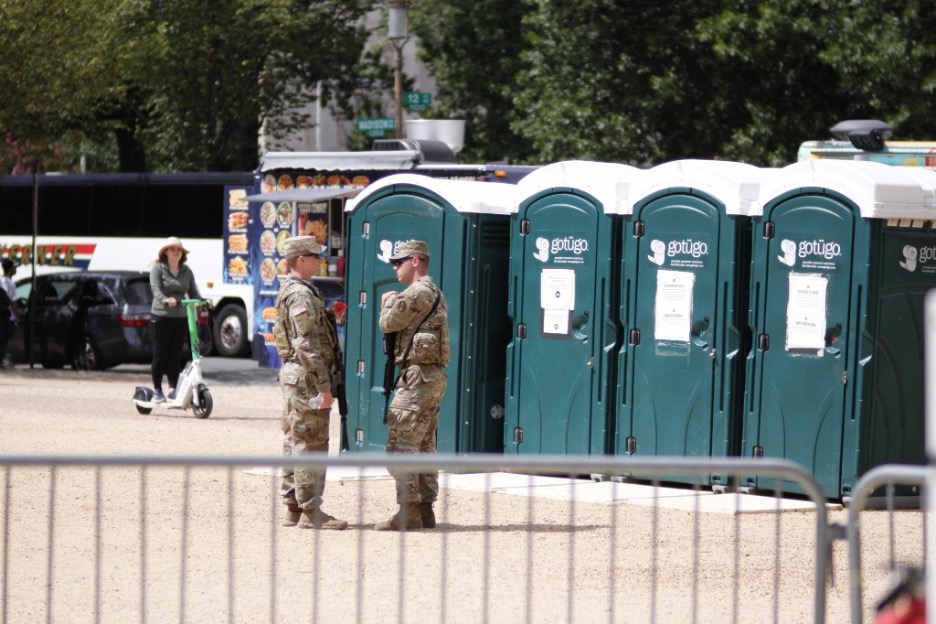Tom Nachbar on "Lawfare and the Authority of Law"
[I am very pleased to introduce the first of two posts from Tom Nachbar of the University of Virginia. In addition to his role as a law professor at UVA, Tom has the distinction of serving as an Army JAG who has worked and written extensively on rule of law-related issues. Check out his paper "Defining the Rule of Law Problem," which is based on a chapter he wrote for the Rule of Law Handbook: A Practitioner's Guide.]
In his earlier posts on the meani
Published by The Lawfare Institute
in Cooperation With

[I am very pleased to introduce the first of two posts from Tom Nachbar of the University of Virginia. In addition to his role as a law professor at UVA, Tom has the distinction of serving as an Army JAG who has worked and written extensively on rule of law-related issues. Check out his paper "Defining the Rule of Law Problem," which is based on a chapter he wrote for the Rule of Law Handbook: A Practitioner's Guide.]
In his earlier posts on the meaning of “lawfare,” Brigadier General Mark Martins is hesitant to describe law as a tool, in part because he is concerned that such an instrumentalist view of law might undermine its authority. That raises a very interesting point, one relevant to the role of law in war generally and to counterinsurgency (the subject of General Martins’ posts) specifically. General Martins does seem to accept that “lawfare” as a term marks out a role for law in the conduct of counterinsurgency separate from law as an end in itself – as a means to some other end – which matches the concept of a “tool” pretty closely. General Martins anticipated and accounted for the law-as-tool problem in some of his prior writing, an Army JAG School casebook he authored while at the National War College: "It is offensive to the notion of “law” to consider judges, courts, commissions, or trials to be “tools” of policy. Yet judges are appointed, courts and commissions established, and trials convened by governments that are formed to serve the interests of societies. Whether a particular judicial institution is serving society’s interest in security well or poorly is a worthy question that need not reduce such institution, in the asking of it, to a mere “instrument” of ends other than justice. Paying Tribute to Reason: Judgments on Terror, Lessons for Security in Four Trials Since 9/11 6 (2d Ed., 2008)" Drawing any conclusion about law’s role in counterinsurgency requires one to describe how law and, along with law itself, legal institutions are used in counterinsurgency. I would like to suggest that there (at least) four distinct ways in which law and legal institutions are used in counterinsurgency: First, counterinsurgents use the criminal law, with all of its normal retributive, deterrent, and incapacitory effects, as a weapon against insurgents. In this sense, the criminal justice system is essentially a substitute for lethal targeting as a means for having direct effects on those who take part in the insurgency. Second, counterinsurgents engage in capacity building of the host nation’s criminal legal institutions because of those institutions’ value in providing the first effect. This effect is similar to the first effect; the difference is in scale and the method. Building legal institutions affects the insurgent movement as a whole, not just particular insurgents. More importantly for my purposes, though, are differences in the primary actors. Those who use law in the first sense are the normal participants in the legal system, and lawyers rightly claim a central role in such uses. This type of capacity building has less connection to the practice of law, though, and has led to many disagreements over who should do it and how it should be done. Third, counterinsurgents build the capacity of criminal legal institutions because using the those institutions to fight insurgency enhances the legitimacy – and therefore the strength – of the government’s side in the insurgency. This use can cover a wide range of possible effects; I’ll cover two of the most obvious: First, using the criminal justice system can give the government the rhetorical advantage of labeling insurgents as criminals. Second, the population might view the procedures and rules of criminal justice as being more likely to lead to fair or accurate outcomes than the raw assertion of force that characterizes alternative means of fighting the insurgency, such as through military force. Fourth, devotion to law and legal institutions can have enhancement of the government’s legitimacy as their primary objective. This use can have wide-reaching consequences that have little direct relation to the counterinsurgency itself but rather are a demonstration of the government’s overall commitment to the rule of law. Sometimes that commitment will actually result in a short-term victory for insurgents – what some might call the insurgents’ “unfair” use of law to hinder military prosecution of the conflict. Perhaps the most salient measure of the legitimacy of any state are the rules (and maybe even more importantly the degree to which the state follows them) that govern its exertion of force, especially exertion of force against its own citizens. As General Martins argues, “[c]ompliance with law is what legitimates the actions of our troops and separates their actions—sometimes necessarily violent and lethal—from what very bad people in criminal mobs do.” If General Martins is correct that most people would rather live under a state that is governed by law rather than the will of men (and I think he is), this use of law may be the most powerful one in the conduct of a counterinsurgency – to again borrow General Martins’ terminology, this is the way the government outflanks insurgents. Anti-corruption efforts, while likely having little direct effect on the insurgency, are an instance of this use of law and legal institutions in counterinsurgency. Breaking down “lawfare” this way highlights the role of – and risks to – law’s authority when law is used as a means to counterinsurgency, or any other form of war. Whether a particular use of the law undermines law’s authority is a product of how closely tied that use is to the set of societal norms and commitments that give the law its legitimacy. General Martins pointed out that “‘legitimate’ must not be conflated with ‘legal.’” He meant it in the sense that empty laws and actions compliant with law that provide no protection will not have authority, and that is certainly true. But legitimacy resides on the other side of the law, too. Codified rules or government practices that enhance security but lack a connection to a population’s normative commitments similarly lack legitimacy – such laws are what Hart described as mere rules backed by force, not law. Thus counterinsurgency doctrine’s central place for legitimacy is doubly the case for uses of law in counterinsurgency. Unlike other non-lethal tools of counterinsurgency (social welfare programs, infrastructure programs such as roads or electrification programs, or even most educational programs), the inextricable connection between this particular tool of counterinsurgency and the population’s underlying normative commitments makes any attempt to use law without attention to its grounding in those commitments – its legitimacy – unwise and likely counterproductive. A corollary is that limited strategies such as counterterrorism, which rely on law strictly as a means to fulfill the operational objective of incapacitating or deterring adversaries, are far more likely to eventually undermine the authority of law than a robust counterinsurgency strategy. If coalition forces view law only as a means to having direct effects on opponents, the temptation will be to use the law selectively when it has the desired effect. It is that selective use of law, not the use of law more generally, that inspires critics of the use of law in war as “unfair” (certainly this opportunistic use of law is what inspires both the derogatory connotations of “lawfare” inherent in Major General Dunlap’s definition and the 2005 National Security Strategy’s dim view of the use of law in warfare) potentially undermines the legitimacy of law itself. General Martins himself drew the distinction, in both his earlier book and his posts on this blog: he attacked what he called the perfidious use of the law and distinguished even among legitimate uses, explaining that the possibility for undermining authority arises when law “merely becomes subordinated as a ‘tool’ or ‘weapon’ in the service of warfare.” A counterterrorism strategy, by so closely tying military and legal means with the limited goal of direct effects on individual terrorists or insurgents, presents a serious threat to the legitimacy of law. Counterinsurgency, by focusing on long-run legitimacy rather than incapacitating any particular insurgent or terrorist, minimizes the threat that the exigency of armed conflict presents to the legitimacy, and hence the authority, of the law. Consequently, I don’t think that the principled use of law in counterinsurgency presents much risk to law’s authority, but the context of armed conflict does have important ramifications for law and efforts at building the capacity of legal institutions, a topic I’ll take up in my next post.
Robert (Bobby) Chesney is the Dean of the University of Texas School of Law, where he also holds the James A. Baker III Chair in the Rule of Law and World Affairs at UT. He is known internationally for his scholarship relating both to cybersecurity and national security. He is a co-founder of Lawfare, the nation’s leading online source for analysis of national security legal issues, and he co-hosts the popular show The National Security Law Podcast.




-(1).png?sfvrsn=dd820f87_5)
